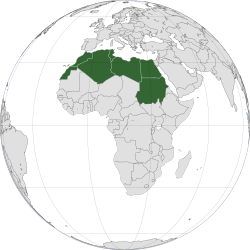
Back Afrika Barôh ACE Noord-Afrika Afrikaans Nordafrika ALS ስሜን አፍሪካ Amharic شمال إفريقيا Arabic شمال افريقيا ARZ África del Norte AST Lentefa Afrika AVK Şimali Afrika Azerbaijani قوزئی آفریقا AZB
| North Africa | |
|---|---|
 | |
| Countries |
Other territories (3)
Partially recognized states (1) |
| Time zones | UTC+00:00 UTC+01:00 UTC+02:00 |

North Africa (sometimes Northern Africa) is a region encompassing the northern portion of the African continent. There is no singularly accepted scope for the region, and it is sometimes defined as stretching from the Atlantic shores of the Western Sahara in the west, to Egypt and Sudan's Red Sea coast in the east.[1]
The most common definition for the region's boundaries includes Algeria, Egypt, Libya, Morocco, Tunisia, and Western Sahara, the territory disputed between Morocco and the partially recognized Sahrawi Arab Democratic Republic. The United Nations' definition includes all these countries as well as the Sudan.[4] The African Union defines the region similarly, only differing from the UN in excluding the Sudan.[5] The Sahel, south of the Sahara Desert, can be considered as the southern boundary of North Africa.[6][7][8] North Africa includes the Spanish cities of Ceuta and Melilla, and the plazas de soberanía. It can also be considered to include Malta, as well as other Italian, Portuguese, and Spanish regions such as Lampedusa and Lampione, Madeira, and the Canary Islands, which are all closer or as close to the African continent than Europe.
Northwest Africa has been inhabited by Berbers since the beginning of recorded history, while the eastern part of North Africa has been home to the Egyptians.[9] In the seventh and eighth centuries, Arabs from the Arabian Peninsula swept across the region during the early Muslim conquests. The Arab migrations to the Maghreb began immediately after, which started a long process of Islamization and Arabization that has defined the cultural landscape of North Africa ever since. Many but not all Berbers and Egyptians gradually merged into Arab-Islamic culture.
The countries and people of North Africa share a large amount of their genetic, ethnic, cultural and linguistic identity and influence with the Middle East/West Asia, a process that began with the Neolithic Revolution c. 10,000 BC and pre Dynastic Egypt. The countries of North Africa are also a major part of the Arab world. The Islamic and Arab influence in North Africa has remained dominant ever since, with the region being major part of the Muslim world. North Africa is associated with the Middle East in the realm of geopolitics to form the Middle East-North Africa region.[10]
- ^ a b Brett, Michael. "Definition: North Africa (region, Africa)". Encyclopedia Britannica. Retrieved 9 September 2021.
- ^ Mattar, Philip (1 June 2004). Encyclopedia of the Modern Middle East and North Africa. Macmillan Reference USA. ISBN 9780028657691.
- ^ De facto government of parts of Western Sahara, claimant to the whole area).
- ^ "UNSD — Methodology". United Nations Statistics Division. Archived from the original on 16 January 2023.
- ^ "The Assembly – African Union". African Union. Archived from the original on 29 November 2018.
- ^ es-Sadi, Abderrahman (1898). Tarikh es soudan (in Arabic). Paris E. Leroux.
- ^ Andrew, McGregor (2001). "The Circassian Qubbas of Abbas Avenue, Khartoum: Governors and Soldiers in 19th Century Sudan" (PDF). Nordic Journal of African Studies. Archived from the original (PDF) on 15 February 2019. Retrieved 25 October 2018.
- ^ Berglee, Royal (17 June 2016). "North Africa and the African Transition Zone". World Regional Geography. Archived from the original on 1 December 2022.
- ^ National Geographic's DNA Analysis Concludes that Egyptians are Only 17% Arab, CairoScene, 16 January 2017
- ^ Güney, Aylın; Gökcan, Fulya (February 2012). "The 'Greater Middle East' as a 'Modern' Geopolitical Imagination in American Foreign Policy". Geopolitics. 15: 22–38. doi:10.1080/14650040903420370.